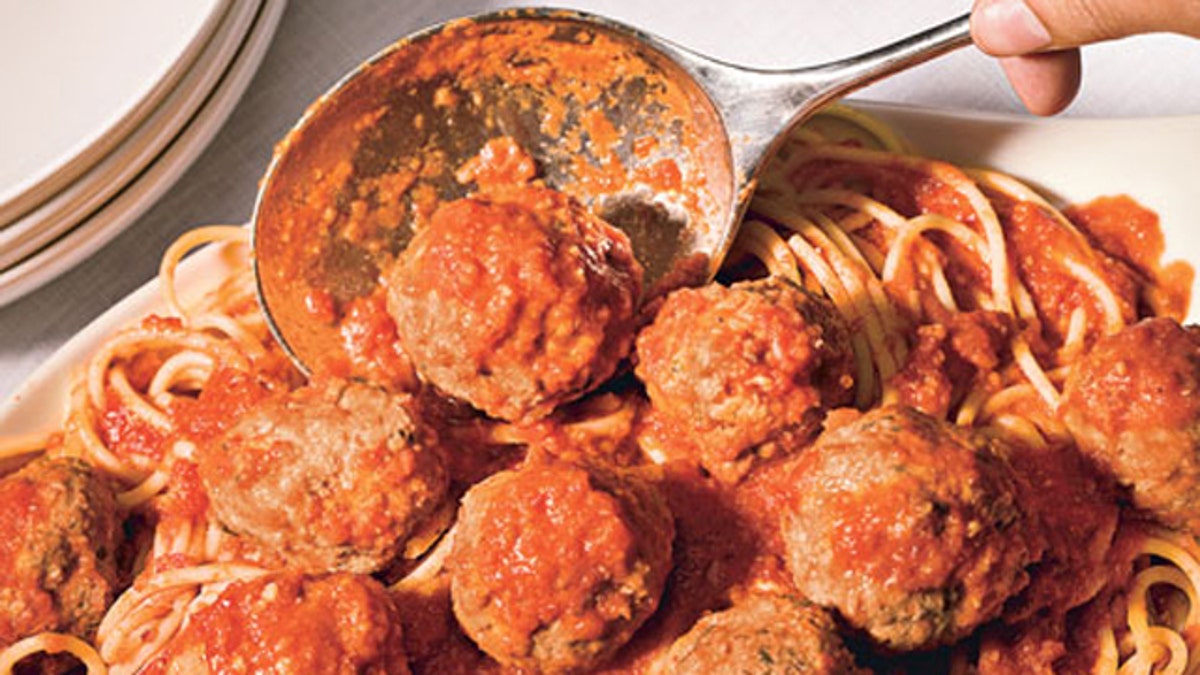
(Elinor Carucci)
I've long felt that if I could make a great meatball, I would be set for life. There's nothing fancy about it, but that's the point. A meatball is about as unassuming as food can get, but when done well, it packs more flavor and more soul per square inch than anything that humble has a right to. People love meatballs. It's a fact of life. If you've got a great meatball in your repertoire, you have the means to make most of the world happy. It took me nearly five years of searching to find my meatball recipe, and in retrospect, that seems like a small price to pay.
My obsession with meatballs—Italian-style, mostly, though I'll take them any way—began about seven years ago, shortly after I ended an almost decade-long stint as a vegetarian. Meat still felt odd and new, and I was timid about it, but I went to an Italian restaurant with a girlfriend and, egged on by a monster of a gin and tonic, wound up ordering spaghetti and meatballs for dinner. The restaurant was all right, and the meatballs weren't special, not in any way that I can remember now, but that night, they tasted almost supernaturally good: hearty, saucy, spiked with Parmesan. And though I knew there were probably better meatballs to be had, the mere fact that they existed at all, that a sphere of seasoned meat could make me so thoroughly ecstatic, was enough to start me wondering how I could get my hands on more, and how they could be made even better.
A person who wants to make meatballs has no shortage of options. There are recipes everywhere. That's very nice, but it doesn't mean that finding a great meatball is easy. Even in the most basic meatball recipe, the number of variables is staggering. Take the meat, for instance: Some recipes call for beef, and others call for pork. Some call for a mixture of beef and pork. Others call for beef, pork, and veal. It's already complicated, and we haven't even gotten around to talking about cheeses, breadcrumbs, herbs, possible frills like ground prosciutto and Aleppo pepper, or whether the meatballs should be cooked in the sauce or separately. I felt stuck before I'd even started.
Being stuck was not an option, and so I forced myself to start cooking. Every time I came across a meatball recipe, I tried it, and every time I got a chance, I ordered them in restaurants. But of all the meatballs I tried, none were totally right. None could nail both taste and texture. It may be hard to believe, but it's entirely possible to make a meatball that tastes like heaven but chews like a foam mattress. It is also possible to make a meatball that's moist, delicate, even silky, but tastes like lightly seasoned air. I never found one that got it all right until I ordered the fettuccine and meatballs at Cafe Lago, in Seattle.
---------
Also from Bon Appétit
The Ultimate Grilled Cheese Guide
Fast Breakfasts from Grocery Store Staples
25 Things to Do with a Fresh Tomato
----------
I'm a big fan of Cafe Lago. I like it so much that I befriended its owners, Carla Leonardi and Jordi Viladas, and wrote about their iconic pomodori al forno in this column a couple of years ago. Jordi learned to make meatballs from his mother, Angeline, and uses a technique from his aunt Polly Schimizzi. Polly mastered meatballs under the guidance of her Calabrian mother. A heritage like that is no joke. When you bite into one of their meatballs, the first thing you notice is that it melts almost instantly. It's impossibly tender, a texture that verges on downy, and then you start chewing, and it opens right up, rich and bright at the same time, the dark sweetness of the meat punched up with Parmesan and fresh parsley.
The ingredients are fairly standard: eggs, Parmesan, parsley, fresh breadcrumbs, salt, pepper, garlic, and equal parts pork and beef, all resulting in a remarkably balanced, well-seasoned meatball. But the linchpin is the texture, and that comes, I learned, with the mixing.
To combine the meat and seasonings, Jordi uses a method I like to call "The Claw." Hold up your hand, fingers separated, and bend your fingers slightly, tensing them. This claw is the best tool for mixing meatballs, and the key is to move it around the bowl in strong, quick circles just until the mixture comes together. Stirring this way makes a meatball with a fine, smooth texture, both tight and light, almost bouncy. When you cut one in half, it doesn't crumble into bits; it holds its integrity. It's a pleasure to eat—not just for how it tastes, but for how it feels between your teeth.
All that's left is to cook it. Jordi simmers his meatballs in a coarse tomato sauce with lots of minced onion and olive oil, and it's a good foil for the earthy meat. But one night last summer, I tried using my own favorite sauce, one from my repertoire. It's a riff on Marcella Hazan's classic sauce with butter and onion, and it's a little richer and rounder, a sauce that I will eat from the pot if left alone in the kitchen. It turns out that when I simmer Jordi's meatballs in it, I not only do that, but I pump my fist in the air with each bite. That's the beauty of a repertoire: that in drawing from a whole world of recipes, you wind up making your own.
THE RECIPE: Spaghetti and Meatballs
